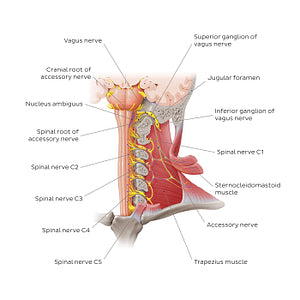Paul Kim
Accessory nerve (English)
Accessory nerve (English)
The spinal root of the accessory nerve originates from the cell bodies of motor neurons located in the upper 5-6 cervical segments of the spinal cord which collectively form the nucleus of accessory nerve. Multiple rootlets exit the spinal cord between the anterior and posterior spinal nerve roots and combine to form the nerve trunk, which ascends the spinal cord and passes through the foramen magnum to enter the cranium. The cranial root arises from motor neurons in the nucleus ambiguus of the medulla oblongata. Rootlets from this nucleus exit from the dorsolateral medulla oblongata and temporarily join with the fibers of the spinal root. Together, they then exit the skull via the jugular foramen. The nerve then divides into two again: the internal branch (cranial root) joins with the vagus nerve to innervate the muscles of soft palate/larynx while the external branch (spinal root) descends into the lateral cervical region of the neck, passing superficially through its posterior triangle. Here the accessory nerve passes deep to the sternocleidomastoid muscle, which it innervates via a muscular branch. It continues to descend in a posterolateral direction, before terminating as a trapezius branch which spans out across the trapezius muscle, supplying it with motor function.Supplementary innervation of the sternocleidomastoid and trapezius muscles is also delivered via homonymous branches of the cervical plexus. These branches contain afferent/sensory neurons, whose cells bodies are located in the spinal ganglia of spinal nerves C2-C4. Some motor fibers are also believed to be delivered to the muscles via this pathway.
Normaler Preis
$7.56 USD
Normaler Preis
Verkaufspreis
$7.56 USD
Grundpreis
pro
Verfügbarkeit für Abholungen konnte nicht geladen werden


#F5DD2D
#A26159
#A12322
#603D32
#F3E096 und #CEB1AB

